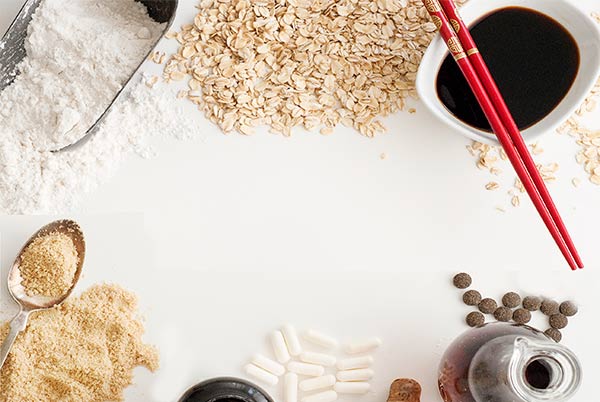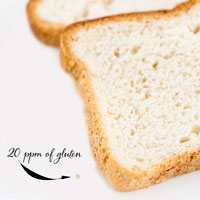
Hunting for Hidden Gluten
Wouldn’t it be lovely if everything with gluten came labeled with a big red “X” on it? Everyone following a strict gluten-free diet needs to be careful about every single crumb of gluten, and being that vigilant can feel like a full-time job! Sometimes gluten is intentionally added to food as an ingredient. Often, gluten is unintentionally added because of the way the food is processed. Here’s the scoop on what you need to know to strictly avoid gluten.
STEP 1: Look for wheat.
Food allergy labeling is required for packaged foods in the US, and it makes our lives much easier. While gluten is found in wheat, barley, rye, and oats by cross-contamination, wheat is by far the most common source of gluten in our food supply. Fortunately, the food allergy labeling rules cover most packaged foods and require that wheat is clearly labeled in plain English. Any wheat-based ingredients will be called out explicitly.
A package may say: Flour (WHEAT). Or it may simply have a line at the bottom saying: Contains WHEAT.
Both don’t need to appear on the package, but one must appear. The good news here is that you don’t need a PhD in chemistry to decode the alphabet soup of additives. Wheat can’t be hidden under colors, flavors, or words you can’t pronounce. It will be spelled out in black and white if it’s an ingredient. If it doesn’t say wheat, wheat wasn’t intentionally added.
So if you see these words on a packaged food item in the US …
- Maltodextrin
- Dextrin
- Food starch
- Modified food starch
- Monosodium glutamate (MSG)
- Distilled vinegar
- Natural colors or flavors
… and you don’t see a note on the label about wheat, you’re good. Whew.
Obviously, many of those funky ingredients still aren’t great for your body, but the first step on a gluten-free diet is recognizing and removing gluten.
STEP 2: Look for barley, rye, and oats.
Barley, rye, and oats are less common than wheat. Barley is often a flavoring agent in cereals, sweets, and savory items like ham or broth. Occasionally, barley can even be in tamari sauce, chocolate, herbal teas, or miso. While regulations don’t require the labeling of barley, it almost always is listed as malt, malt flavoring, malt extract, malt vinegar, brewer’s yeast, or – very rarely – autolyzed yeast extract.
Rye is generally only found in rye bread, which is off the table for many reasons. Oats often make an appearance in breakfast products and granolas. Dates may be dusted with oats to keep them from sticking together. If purchasing oats, look for certified gluten-free oats.
All in all, there are only a handful of words to watch out for when gluten is added as an ingredient:
- Wheat
- Barley
- Rye
- Oats (not marked gluten-free)
- Malt, malt extract, malt flavoring, malt vinegar
- Brewer’s yeast or autolyzed yeast extract

STEP 3: Look out for cross-contamination.
Okay, so we’ve figured out the words that mean that gluten is an ingredient, and there aren’t that many. However, half the battle is the gluten that wasn’t intentionally added into a product as an ingredient, which is called cross-contamination.
The amount of gluten that can cause a problem for someone with celiac disease is ridiculously tiny. Generally, under 20 ppm (parts per million) is considered safe. Let’s put that into perspective. If you take a piece of bread and divided it into about 5,000 pieces, ONE of those crumbs is equivalent to 20 ppm – the maximum amount of gluten someone with celiac could safely eat.
Gluten contamination often happens accidentally. It can happen when wheat is grown in a field right next to a gluten-free grain and the wind carries a few seeds over that become mixed with the gluten-free grain. It’s a common problem when the same mill is used both for gluten and non-gluten grains. Due to airborne flour, there’s no safe way to mill gluten and non-gluten grains together. Airborne flour is also a huge problem in bakeries or small commercial kitchens for the same reason. Cross-contamination can also happen anywhere else in production if manufacturers aren’t taking care to avoid it.
Several studies show that the foods with the greatest amount of cross-contamination are flours, grains, and products made from flour and grains. So as a general rule, the best way to make sure to avoid cross-contamination is to only purchase flours and grain-based products that are specifically labeled gluten-free. Ideally, these products are certified through the Gluten Intolerance Group, Celiac Support Association, or National Foundation for Celiac Awareness. This includes flours, whole grains, and flour-based products like cereals, rice chips, breads, tortillas, etc.
Sneaky Impostors
It’s entirely too easy to grab the wrong product, especially when you’re in a hurry. For example, General Mills labels its line of Rice Chex cereals as gluten-free, but the store brand versions generally contain barley malt. There are many candies that are typically gluten-free, like Reese’s Peanut Butter Cups or York Peppermint Patties, but the special holiday shapes use a different recipe that contains gluten. Some brands of butterscotch chips are gluten-free, while others contain barley malt. Rudi’s sells gluten-free bread, but they have a gluten-full line as well. The list goes on and on. Long story short, it’s really easy to make a mistake or grab a similar box. It’s absolutely necessary to read every single label for gluten, every single time.
Exceptions
While most foods will fall under the labeling regulations mentioned previously, there are some exceptions.
MEAT, EGG, AND POULTRY PRODUCTS: Legally, these foods fall under slightly different labeling rules. Approximately 80-90 percent of companies in this category voluntarily label food allergens, but there are no formal regulations. If you’re reading a label for a meat, dairy, or egg product that isn’t labeled gluten-free, be sure to double-check on the company’s website or call the manufacturer.
IMPORTED FOODS: In theory, imported foods legally have to follow the same standards as the US for imports. In practice, not so much. Countries in the European Union have standards for labeling gluten, so if you see a product specifically labeled gluten-free, great. But all bets are off when it comes to what you find at your local Hispanic, Middle Eastern, African, or Thai market. Don’t assume that it’s gluten-free just because it’s from a country that doesn’t historically eat much wheat.
MEDICATIONS: These are the wild, wild west! There are regulations requiring disclosure of the source of ingredients, so the only way to know if your medication contains gluten is to call the manufacturer or to have your pharmacist make the call. Over-the-counter medications (like cough drops, antacids, pain relievers, etc.) can contain gluten, too. Make sure you do your research and find safe options before you’ve got a fever at 3 a.m. Two great websites with a wealth of information are glutenfreedrugs.com and pillbox.nlm.nih.gov.
BEER: Some beer is made from gluten-free grains like sorghum, millet, or rice. However, there are a few “gluten removed” beers on the market. These are made with barley and processed to remove the gluten, then tested to be below the threshold of 20 ppm of gluten. The problem is that scientists at the FDA and abroad say the tests aren’t designed to accurately assess gluten levels in fermented products like beer, so there’s still a big question mark. Bottom line: until the powers-that-be agree that “gluten removed” beers are safe, stick with beer from non-gluten grains.
Label Reading
When you’re purchasing prepared foods or you’re out to eat, all bets are off on words and names for wheat. Always ask questions, even if someone says a product is gluten-free. Better yet, ask if you can take a look at the label and read it yourself. Here are common words that generally mean a dish contains wheat:
- Bulgar
- Couscous
- Durum
- Einkorn
- Emmer
- Farina
- Farro
- Flour
- Freekah
- Fu
- Kamut
- Matzo
- Seitan
- Semolina
- Soy Sauce
- Spelt
- Tabbouleh
- Teriyaki sauce
- Textured vegetable protein (VTP)
- Triticale
ABOUT THE AUTHOR:
Cheryl Harris is an award-winning Registered Dietitian, Nutritionist, and Certified Wellness Coach helping clients learn to live and love a gluten-free lifestyle. She is a contributor to the Washingtonian and Today’s Dietitian and has presented for the FDA, USDA, and many others. Find Cheryl at www.harriswholehealth.com and www.gfgoodness.com.
As always, consult a medical professional before beginning any new protocol.




Pingback: Gluten…seriously? | Gluten Free Goodness
Pingback: Gluten Free Grilled Orange Chicken Recipe | Simply Gluten Free
Pingback: Gluten Free Nutty Tarts Recipe | Simply Gluten Free
Pingback: Gluten-free Coffee Barbeque Sauce | Gluten Free Recipes | Blog